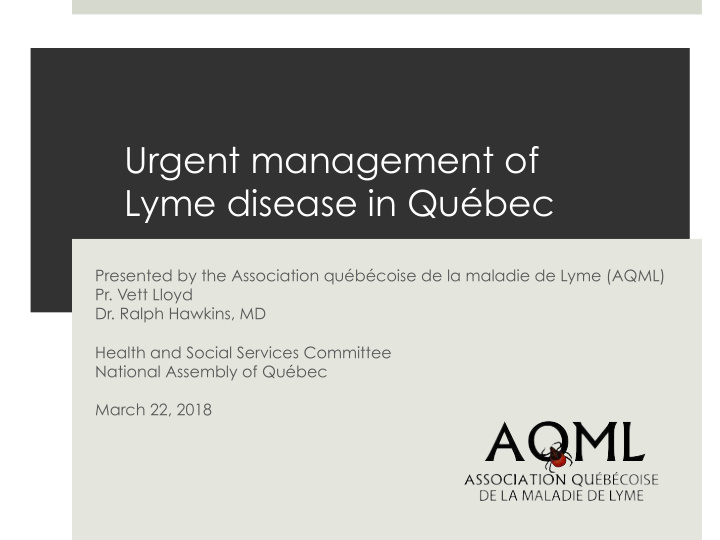



Urgent management of Lyme disease in Québec Presented by the Association québécoise de la maladie de Lyme (AQML) Pr. Vett Lloyd Dr. Ralph Hawkins, MD Health and Social Services Committee National Assembly of Québec March 22, 2018
AQML, in short ¤ The Association québécoise de la maladie de Lyme (AQML) was founded in 2013 by a few québécoises who were ill with Lyme disease and its co-infections ¤ Charitable volunteer organisation ¤ 240 official members (1300 on Facebook help group) ¤ Sectors of intervention: ¤ Help and support for those who are ill ¤ Information dissemination for the public ¤ Representation with decision makers
AQML Survey, March 2018 ¤ Carried out between March 12 and 17, 2018, with AQML members and on our social media platforms ¤ 202 respondents included (out of 204) ¤ Inclusion criteria: have Lyme disease (clinical diagnosis or blood tests, in Québec or elsewhere) ¤ tick bite in Québec; or ¤ health problems that started in Québec; or ¤ be a resident of Québec. ¤ Some questions offered multiple choices
Worst aspects of the illness
Ticks in Quebec – the problem that we know about Ixodes scapularis Borrelia burgdorferi Lyme disease We monitor the established populations of I. scapularis But what about the other species of ticks and the other species of Borrelia?
The problems that we don’t monitor – Introduced ticks and their introduced pathogens Amblyomma americanum Introduced ticks carry pathogens we don’t test for Ixodes hexagonus B. afzelii acquired locally Meat allergy Borrelia lonstari - STARI Borrelia burgdorferi - Lyme disease Borrelia burgdorferi - Lyme disease Borrelia garinii – Lyme disease Borrelia andersonii – Lyme-like Borrelia afzelii – Lyme disease Borrelia americana – Lyme-like Erlichia sp . – erlichioses Erlichia sp . - erlichioses Babesesia sp . - Babesiosis Francisella tularensis – tularemia Tick encephalitis virus Heartland virus
Borrelia miyamotoi Transmission of B. The standard blood tests do miyamotoi from mother not detect B. miyamotoi to fetus in % infections mice leads to propagation of infection in 10 Tiques 2012 wildlife 8 reservoir species Tiques 2016 6 4 souris 2 sauvages 0 2016 B. miyamotoi Clinical diagnosis is essential because the standard blood test cannot detect the diversity of Borrelia with which humans can become infected. We do not know the diversity of Borrelia pathogens in ticks or wildlife
Here are 100 people who have early Lyme Borreliosis with Erythema Migrans
C6 testing is 64% sensitive in Acute erythema migrans
C6 testing is 64% sensitive in Acute erythema migrans
Only 33 people with early erythema migrans will have positive IgG 2-tier
The majority of Lyme patients will have strains that perform poorly on the second tier of testing
Current testing carries unacceptably high likelihood of false negative results
NML data 2011 to 2015
C6 as a single-tier test carries reliable accuracy, sensitivity and specificity Single-tier C6 performs Single C6 Accuracy = 98.75% comparably to other Sensitivity = 97.2% diagnostic tests; 2-ELISA (most sensitive method) method is most accurate
Immunetics C6 Product monograph “Negative results (either first or second step) should not be used to exclude Lyme disease”
Does symptom persistence following antibiotics go against the diagnosis of early disseminated Lyme Borreliosis? One in seven treated patients will have prolonged disability
Clinical Diagnoses of Lyme Borreliosis Expanding the acceptable criteria Definite Probable Plausible
Core Standards for Evidence in Canadian Law • Proof beyond a reasonable doubt • Proof on a preponderance of the evidence; or balance of probabilities (>50%) “More likely than not”. • Evidence raising a reasonable doubt. (In science of statistics, we typically set the limit for chance findings at 5%; or set confidence limits at 95%, meaning “19 times out of 20”).
Proposed Standards to Define a Clinical Diagnosis of Lyme Borreliosis • Definite – Proof beyond a reasonable doubt - Status quo – CDC criteria; two-tier testing; culture of the organism; one- tier IgG immunoblot; CSF studies • Probable – Proof on a preponderance of the evidence; or balance of probabilities; a single positive test with LR+ >10 – More likely than not that Lyme disease is present; a solitary positive C6 or a later than 4 week CDC criteria 2-tier IgM Immunoblot; positive Elispot test or positive serum PCR • Plausible – Evidence raising a reasonable doubt; a positive test result with LR+ >5; or more than one test with LR+ >2 – Patient is more likely than a random member of the public to have Lyme disease. e.g. Positive test result from studies that have less than 95% specificity; non-standardized tests with more than minimal decision-making impact
AQML asks for… ¤ The official recognition of chronic Lyme disease and its co-infections as serious health issues and an urgent public health problem . ¤ Legal protection for doctors providing care based on more effective protocols recognized worldwide ¤ A concrete action plan to tackle Lyme disease and its associated issues, put together in close collaboration with AQML, our experts and members.
We are counting on you, thank you!
Recommend
More recommend